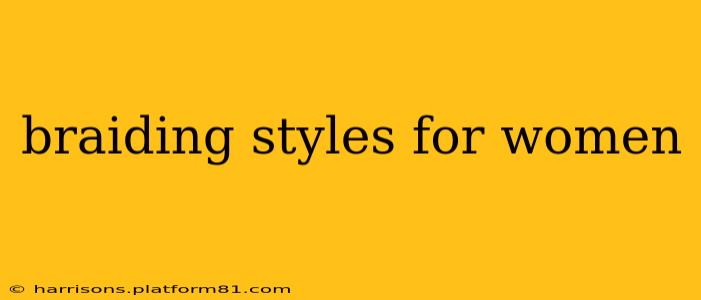Braids are a timeless hairstyle, offering versatility, elegance, and practicality for women of all ages and hair types. From simple everyday styles to intricate, show-stopping creations, the world of braiding offers endless possibilities. This guide explores a range of braiding styles for women, catering to different skill levels and preferences. We'll delve into classic techniques, modern twists, and answer frequently asked questions to help you find the perfect braid for any occasion.
What are the Different Types of Braids?
Before diving into specific styles, let's establish a foundation by understanding the core braid types:
-
Three-Strand Braid: This is the most fundamental braid, involving the interweaving of three sections of hair. Variations include the classic Dutch braid (braided underneath the hair), French braid (braided close to the scalp), and the English braid (braided on top of the hair).
-
Fishtail Braid: A more intricate braid that uses only two sections of hair, creating a delicate, elegant look with a textured appearance.
-
Dutch Braid: As mentioned above, this braid is created by crossing strands underneath each other, resulting in a raised, textured braid that sits on top of the head. It's incredibly versatile and can be incorporated into many styles.
-
French Braid: This classic braid starts at the crown and incorporates strands of hair as you braid down the length. The result is a sleek, sophisticated look that can be worn for both casual and formal events.
-
Pull-Through Braid: This relatively easy braid style creates a cascading effect, perfect for medium to long hair. It’s achieved by pulling sections of hair through each other, creating a unique and stylish look.
-
Waterfall Braid: This romantic braid style incorporates loose strands of hair to create a cascading waterfall effect. It’s a beautiful choice for special occasions or weddings.
What is the Easiest Braid to Learn?
The three-strand braid is undeniably the easiest braid to learn. Mastering this basic technique opens the door to many more complex styles. Start with practicing on a single strand of hair, then move on to braiding your own hair. Plenty of online tutorials can provide visual guidance and step-by-step instructions.
How Do I Braid My Own Hair?
Braiding your own hair might seem challenging at first, but with practice, it becomes much easier. Start with the basic three-strand braid, focusing on consistent tension and even sections. Use a mirror to monitor your progress, and don't be discouraged if your first attempts aren't perfect. Many online tutorials demonstrate step-by-step instructions for different braid types, catering to various skill levels.
What Braiding Styles are Best for Long Hair?
Long hair offers the greatest flexibility for braiding. Styles like the French braid, Dutch braid, fishtail braid, and intricate variations using multiple braids are all excellent choices. Consider incorporating braids into updos, creating elaborate crown braids, or experimenting with cascade braids for a truly breathtaking look.
What Braiding Styles are Good for Short Hair?
Even with short hair, you can still enjoy the versatility of braiding. Consider mini braids, incorporated into a half-updo or used to accentuate specific sections of hair. Braids can be used to create the illusion of longer hair. Experiment with smaller, tighter braids to achieve the best results.
What are Some Trendy Braid Styles Right Now?
Current trends showcase the creative potential of braiding. We're seeing a surge in popularity for:
- Space buns with braids: Two braided space buns are a cute and playful hairstyle.
- Bohemian braids: Loose, textured braids, often combined with flowers or accessories.
- Braided pigtails: A classic style updated with intricate braids.
- Halo braids: A romantic style that encircles the head.
This is just a glimpse into the vast world of braiding styles for women. Experiment with different techniques, find styles that complement your hair texture and face shape, and most importantly, have fun! The possibilities are truly endless.
